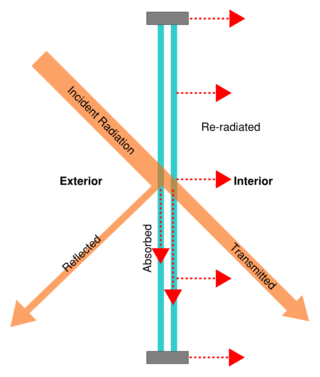
Back اكتساب حراري شمسي Arabic Ganancia solar Spanish بهره خورشیدی Persian Facteur solaire French Zontoetredingsfactor Dutch
This article needs additional citations for verification. (September 2014) |


Solar gain (also known as solar heat gain or passive solar gain) is the increase in thermal energy of a space, object or structure as it absorbs incident solar radiation. The amount of solar gain a space experiences is a function of the total incident solar irradiance and of the ability of any intervening material to transmit or resist the radiation.
Objects struck by sunlight absorb its visible and short-wave infrared components, increase in temperature, and then re-radiate that heat at longer infrared wavelengths. Though transparent building materials such as glass allow visible light to pass through almost unimpeded, once that light is converted to long-wave infrared radiation by materials indoors, it is unable to escape back through the window since glass is opaque to those longer wavelengths. The trapped heat thus causes solar gain via a phenomenon known as the greenhouse effect. In buildings, excessive solar gain can lead to overheating within a space, but it can also be used as a passive heating strategy when heat is desired.[1]
- ^ Frota, Anesia Barros (1999). Manual de conforto termico. Sueli Ramos Schiffer (3rd ed.). Sao Paulo: Studio Nobel. ISBN 85-85445-39-4. OCLC 46753712.
© MMXXIII Rich X Search. We shall prevail. All rights reserved. Rich X Search